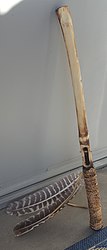Clapper stick
Appearance
 Clapper stick | |
| Percussion instrument | |
|---|---|
| Classification | hand percussion |
| Hornbostel–Sachs classification | 111.11 (Directly struck stick concussive idiophone) |
| Indigenous music of North America |
|---|
| Music of indigenous tribes and peoples |
| Types of music |
| Instruments |
| Awards ceremonies and awards |
A clapper stick (also clap-stick or split stick rattle) is a traditional idiophone common among the indigenous peoples of California. It is traditionally constructed by cutting the branch of an elderberry tree, hollowing it out, and partially splitting the branch in two. It is used to keep time and accompany singers and dancers. Many are now made of bamboo, which do not require hollowing.[1][2][3]
Names in Indigenous California Languages
- Central Sierra Miwok: țakáț'a[4]
- Chukchansi: tá-wit[5]
- Chumash: wansak[6]
- Hupa: kinah¬dun-ts’e:y’[7]
- Maidu: pak'papa[8]
- Mutsun: sallik[9]
- Northern Paiute: hau tsavaiya[10]
- Northern Pomo: hay bit’abit’aka[11]
- Plains Miwok: taka'tta[12]
- Serrano: pă-how-it[9]
- Tongva: araawkewe[13]
- Tubatulabal: ka*ba.ba.ynis't [14]
- Western Mono: anawataki'inu[9]
- Wintu: lasasus[15]
- Yuki: al-lah-chi'-mah[9]
See also
References
- ^ De Angulo, Jaime; Garland, Peter (1988). Jaime de Angulo : the music of the Indians of Northern California. Santa Fe: Soundings Press. ISBN 978-9999517324.
- ^ Keeling, Richard (1992). "Music and Culture Areas of Native California" (PDF). Journal of California and Great Basin Anthropology. 14 (2).
- ^ Kidder, Norm. "Musical Instruments of Central California". Primitive Ways. Retrieved 4 August 2018.
- ^ Freeland, L.S.; Broadbent, Sylvia M. (1960). Central Sierra Miwok Dictionary with Texts. p. 30.
- ^ Curtis, Edward. The North American Indian. Vol. 14. p. 246.
- ^ Bial, Randall; Newsome, Joel (2017). The People and Culture of the Chumash. Cavendish Square. p. 73. ISBN 978-1502622556.
- ^ "Hupa Language Dictionary". Humboldt Digital Scholar. Retrieved 28 August 2018.
- ^ Template:Cite article
- ^ a b c d "Hunter-Gatherer Language Database". University of Texas. Retrieved 29 August 2018.
- ^ Pietroforte, Alfred (1965). Songs of the Yokuts and Paiutes. Naturegraph Publishers, Healdsburg, CA. p. 19.
- ^ "Northern Pomo Dictionary". Northern Pomo Online Talking Dictionary. Retrieved 5 August 2018.
- ^ Barrett, Samuel A.; Gifford, Edward W. (198-). Indian Life of the Yosemite Region: Miwok Material Culture. Yosemite Association, Yosemite National Park, CA. p. 249.
{{cite book}}: Check date values in:|date=(help) - ^ "Tongva Word of the Day". Tongva Language Facebook page. Retrieved 28 August 2018.
- ^ Voegelin, Erminie W. (1938). Tübatulabal Ethnography. p. 35.
- ^ DuBous, Cora. Wintu Ethnography. Vol. 36. p. 123.
